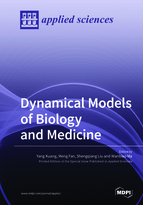Dynamical Models of Biology and Medicine
A special issue of Applied Sciences (ISSN 2076-3417). This special issue belongs to the section "Applied Biosciences and Bioengineering".
Deadline for manuscript submissions: closed (30 September 2016) | Viewed by 93321
Special Issue Editors
Interests: mathematical and computational biology and medicine; delay differential equations; mathematical models; applied mathematics
Special Issues, Collections and Topics in MDPI journals
Interests: mathematical biology and medicine; functional differential equations; dynamical systems
Interests: mathematical epidemiology; mathematical population dynamics; dynamical system
Interests: differential equation models in epidemiology; virology and mirobiology and population biology; stability and bifurcation of ordinary/delayed differential equations
Special Issues, Collections and Topics in MDPI journals
Special Issue Information
Dear Colleagues,
Mathematical and computational modeling approaches in biological and medical research are experiencing exponential growth globally. This Special Issue intends to catch a glimpse of this exciting phenomenon. Areas covered include general mathematical methods and their applications in biology and medicine, with an emphasis on work related to mathematical and computational modeling, and to nonlinear and stochastic dynamics.
Topics appropriate for this Special Issue include, but are not limited to, all areas of mathematical biology and medicine that employ dynamical (differential equation) models to describe observed nonlinear dynamics that aim to understand life science problems. To be considered by this Special Issue, a paper should be in one (or a combination) of the three categories. (a) papers developing and mathematically analyzing dynamical models that have concrete applications in biology or medicine; (b) papers devoted to mathematical theory and methods, with a clear life science motivation, whose results may lead to an improved understanding of the underlying problem; and (c) papers using numerical simulations, experiments, or both to reveal or explain some new life science phenomena, where mathematical analysis plays a useful role in the process.
All paper must contain a comprehensive introductory section and an in-depth discussion section that is closely tied to applications. The scientific importance and motivation of the paper and its conclusions should be made clear at the outset.
Prof. Dr. Yang Kuang
Prof. Dr. Meng Fan
Prof. Dr. Shengqiang Liu
Prof. Dr. Wanbiao Ma
Guest Editors
Manuscript Submission Information
Manuscripts should be submitted online at www.mdpi.com by registering and logging in to this website. Once you are registered, click here to go to the submission form. Manuscripts can be submitted until the deadline. All submissions that pass pre-check are peer-reviewed. Accepted papers will be published continuously in the journal (as soon as accepted) and will be listed together on the special issue website. Research articles, review articles as well as short communications are invited. For planned papers, a title and short abstract (about 100 words) can be sent to the Editorial Office for announcement on this website.
Submitted manuscripts should not have been published previously, nor be under consideration for publication elsewhere (except conference proceedings papers). All manuscripts are thoroughly refereed through a single-blind peer-review process. A guide for authors and other relevant information for submission of manuscripts is available on the Instructions for Authors page. Applied Sciences is an international peer-reviewed open access semimonthly journal published by MDPI.
Please visit the Instructions for Authors page before submitting a manuscript. The Article Processing Charge (APC) for publication in this open access journal is 2400 CHF (Swiss Francs). Submitted papers should be well formatted and use good English. Authors may use MDPI's English editing service prior to publication or during author revisions.
Keywords
- dynamical system
- mathematical biology
- mathematical medicine
- simulation
- stability
- bifurcation
Benefits of Publishing in a Special Issue
- Ease of navigation: Grouping papers by topic helps scholars navigate broad scope journals more efficiently.
- Greater discoverability: Special Issues support the reach and impact of scientific research. Articles in Special Issues are more discoverable and cited more frequently.
- Expansion of research network: Special Issues facilitate connections among authors, fostering scientific collaborations.
- External promotion: Articles in Special Issues are often promoted through the journal's social media, increasing their visibility.
- e-Book format: Special Issues with more than 10 articles can be published as dedicated e-books, ensuring wide and rapid dissemination.
Further information on MDPI's Special Issue policies can be found here.








